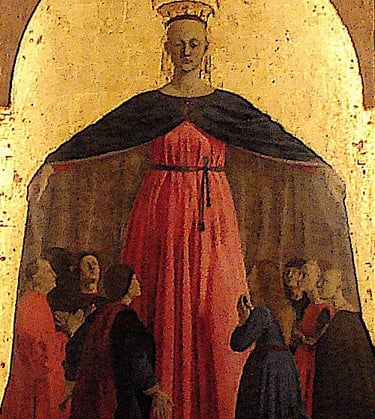Artistic Traditions
Dr. Victoria King
My sensibilities as an artist have been formed by a rich legacy of art history. In Florence at the Santa Maria Novella, I was thrilled by seeing the humanism and use of perspective in Masaccio's 'Trinity’, and by Uccello's haunting visions and the transience of his pigments. In Arezzo, I was humbled by Piero della Francesco’s intimate depictions of loved ones and his Tuscan homeland, and in Siena by Duccio's Maesta and predellas. I went to Assisi intending to spend one day and night, and spent a week feeling yet again the dizzying effects of Stendhal's Syndrome in front of the frescoes of Giotto and Cimabue. I made annual pilgrimages to Tuscany and Umbria, and each time felt awe and joy in the sublime beauty of early Renaissance artists and their iconic Byzantine origins.
I have a highly eclectic appreciation of art history which includes Malevich who paid homage to his own Russian iconic tradition some 500 years later. I honour Bonnard, Monet, Matisse, and Van Gogh for making colour sacred to their work, and Cezanne for his ground-breaking late watercolours. His experiments in pure seeing were carried out with determination and intention, not ego. He painted the moment of perception, transforming sensation into touches of colour and creating space. I was drawn to the work of the early Abstract Expressionists in America, many of whom were European émigrés. They paid homage to the spatial flatness Cezanne had achieved, and made process paramount to their artworks as their bodies became vehicles for expression. Their interests in Eastern mysticism and native American art often informed their paintings which were vast in scale and ambition.
At art college, I initially wanted to study sculpture perhaps because of my love of ethnographic art, yet the tutors firmly directed me to the painting department. The results of my working with the eminent painter Paul Chidlaw in his Mt. Adams' studio in Cincinnati as a young woman were clearly evident to them. My appreciation of Rodin, Giacometti, and ethnographic have not diminished, but only grown stronger, and now includes the work of Louise Bourgeois.
In Australia, I was surrounded by the vast, almost transcendental spaces that I had previously tried to create in my English paintings. What I knew intellectually I could see and feel viscerally and emotionally. Flatness emerged spatially through enormous expanses of earth and sky, vistas imbued with light and colour. Many traditional Australian Aboriginal artists now draw on ancient ceremonies and Dreaming stories to create congruent and extraordinary ways to depict the spirit and space of land for which they are custodians. I brought visual baggage to Australia, and constantly struggled to find ways to express the land’s sublime expansiveness, its fragile diversity, timelessness, and precarious vulnerability. I tried to make my paintings vehicles for the natural beauty that surrounded me and for my experiences, but never came close to the authenticity that I saw within Aboriginal artworks and those of other indigenous cultures.
Photographs of Cimabue crucifix and early Renaissance Madonna taken by Victoria King in Italy.
© Copyright text Victoria King 2022



